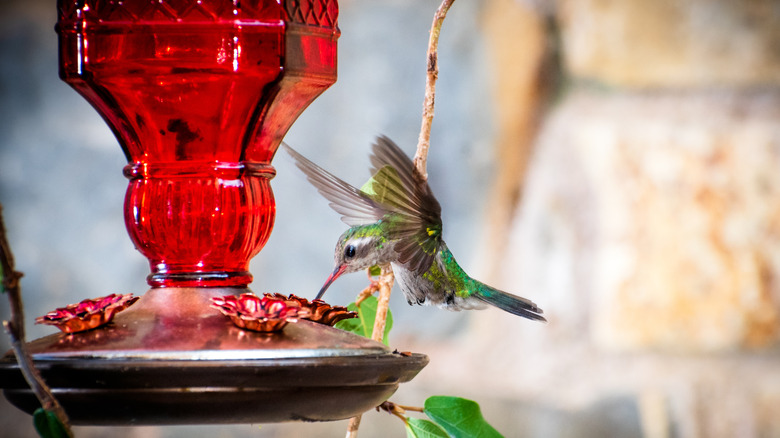The Only Type Of Sugar You Should Use In Hummingbird Nectar
We may receive a commission on purchases made from links.
The hummingbird is a much-sought-after guest in any garden, as its striking appearance and fluttering movements give anyone a moment to pause and appreciate the beauty of nature. Those with pets will also enjoy the adorable reaction of a curious cat hanging out in a window to watch it or a dog excited by the colorful bird's unique movement. To respect the hummingbird, providing only the safest nectar is essential.
Nectar feeders are a popular choice for attracting hummingbirds to a yard or balcony, but the only sugar that should be used is refined white sugar. A hummingbird sugar water recipe is straightforward: combine one part sugar and four parts water. You can heat it on the stove to dissolve the sugar, but let the mixture cool completely before putting it into your feeder. Leftover water that doesn't fit in your feeder can be safely stored in the refrigerator for about a week. The feeder should be cleaned and refilled at least twice a week during the summer months and once a week in the winter to circumvent mold build-up. While red dye was once commonly used to help lure hummingbirds, additives are unnecessary and potentially harmful. Red dye and other sugars or sweeteners can lead to faster nectar decay and potential fungal growth that can harm a hummingbird.
Cleanliness and the use of proper ingredients are key to protecting the hummingbird population, as consuming mold, particularly black mold, can lead to a deadly condition known as candidiasis. This infection results in a swollen tongue, which prevents a hummingbird from eating. With proper care, a nectar feeder is perfectly safe, but there are various ways to optimize an outdoor space to help entice a hummingbird.
The best ways to safely attract hummingbirds without using red dye in your nectar
The uplifting presence of the colorful, fast-moving bird has led many to wish they could keep a hummingbird as a pet, which is a costly mistake in many ways. However, since ownership isn't a viable option, other ways exist to optimize an outdoor space to entice the winged beauty. Red dye is indeed harmful, but choosing a red feeder with bright colors throughout, such as the WOSIBO Hummingbird Feeder, and accenting it with red ribbons is an easy way to make the feeder more attractive to hummingbirds. Generally, decorating outdoor spaces with red can help bring in more hummingbirds.
Accenting any garden or outdoor space with plants that attract hummingbirds presents a win-win for those with a green thumb and the fanciful bird. Popular pollinators enticing to hummingbirds include salvias, petunias, honeysuckle, foxglove, and fuchsia. While spider webs may not be desired by everyone, allowing a web to thrive provides a hummingbird with material they use to build their nests. Moreover, tailoring an outdoor space to attract prey such as gnats, ants, mites, and mosquitoes can provide a vital part of a hummingbird's diet, maximizing the chances the colorful bird will return for more.
Using the right sugar in a nectar feeder is essential for a hummingbird's health, but it's only one of many steps people can take to welcome the treasured bird into their space. A diverse outdoor space can be a joy for the fanciful flier and a bird-loving person alike.

